Running a successful Google search campaign has always been a lot like playing baseball. If you’re good, you’re likely to hit at least a few home runs—but you’ll probably have your fair share of strikeouts too.
With responsive search ads (RSA), however, you have a better chance of advancing from base to base and eventually scoring a run. That’s because Google’s new default ad type for search campaigns makes optimization faster and easier than ever.
In this article, we’ll walk you through getting started with this type of pay-per-click (PPC) ad. Find out how responsive search ads work and learn why and how to include them in your next Google ad campaign.
Get brand new Google ad strategies straight to your inbox every week. 23,739 people already are!
What is a responsive search ad?
A responsive search ad appears on the search engine results page (SERP), where it displays the optimal combination of ad copy (according to Google’s algorithm). This type of PPC ad automatically determines which copy to show and in what sequence to craft the most effective message for each searcher.
When you create a responsive search ad, you provide multiple headline and description line options—far too many for a single ad to show. Ads that run on the Google Search Network can only display up to three headlines and two descriptions.
When Google serves your ad, it tests out different combinations of the headlines and descriptions you provided. Then it identifies top performers and matches the best permutations with relevant searches.
Components of a responsive search ad
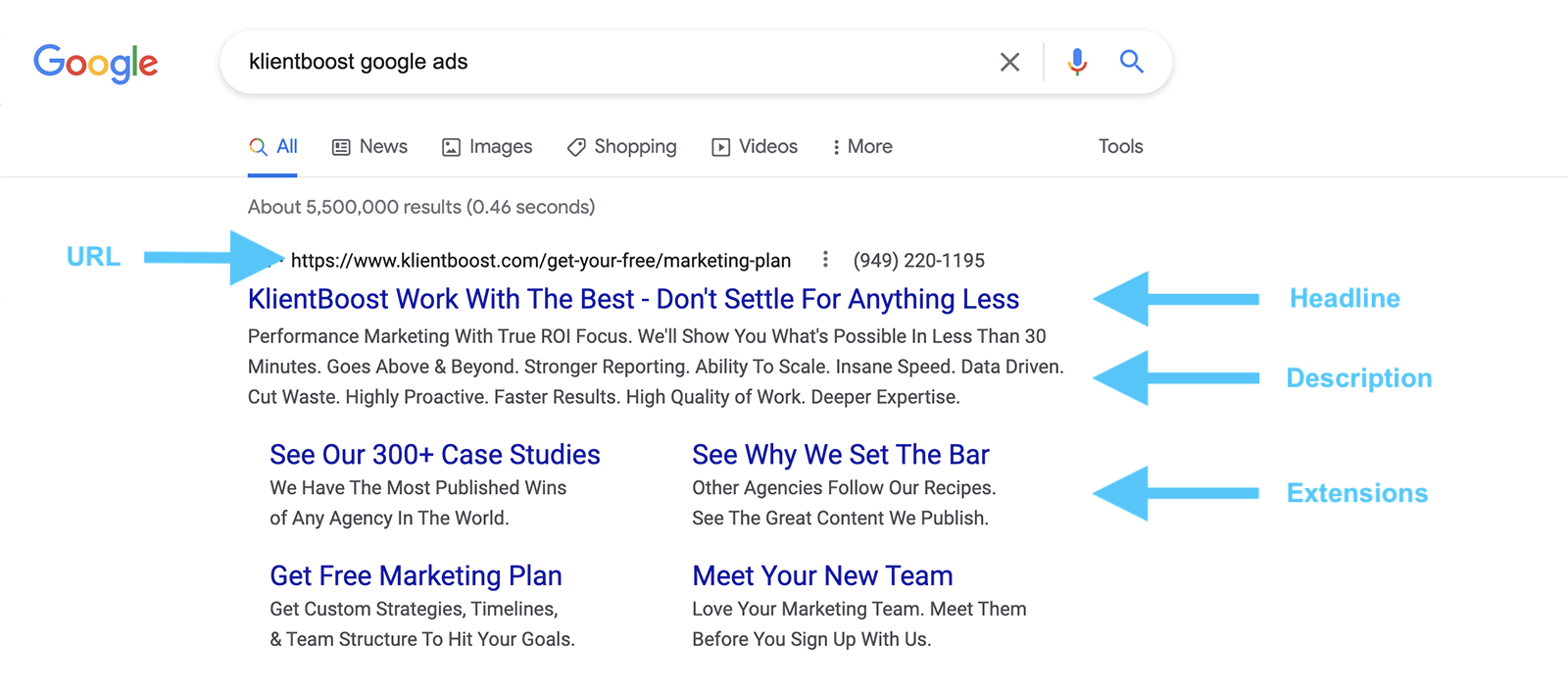
Your RSA may look a little different depending on the search terms and where the results display. Yet most responsive search ads include these components:
- URL: The actual or display URL for your landing page, where potential customers arrive after clicking on your ad
- Headline: The short, hyperlinked copy that’s designed to grab your attention at the beginning of the ad
- Description: The lengthier copy that forms the body of the ad and explains your offer and its benefits
- Extensions: Additional hyperlinks below the description that give searchers more opportunities to click
Dynamic search ads vs. responsive search ads
To the average Google search user, dynamic and responsive ads essentially look identical. But for marketers, these ad formats are in different leagues.
When you create a dynamic ad group, you don’t have to write any headlines or descriptions. In fact, you don’t even need keywords.
Instead, you input the landing page URLs that you want to target. Google Ads automatically analyzes the content on each landing page and generates headlines and descriptions that match relevant search queries.
Dynamic search ads have the advantage of being incredibly quick and easy to create. You can set up an ad group in about a minute, as long as you know which landing pages you want to target.
However, dynamic ads have some serious shortcomings too. Since these PPC ads don’t allow ad copy, you can’t control the messaging your prospects see. These ads also make it difficult to track top-performing ad elements or optimize campaigns manually.
That’s why Google recommends running both responsive and dynamic search ads. When you run both simultaneously, you can maximize your targeting options and capture as much search traffic as possible.
Why you should run RSA on Google Ads
Google’s responsive search ads offer several helpful advantages:
Master Google Ads’ new default ad type
If you already run search campaigns, then you might be used to creating expanded text ads. In August 2021, Google announced a major change to its search campaign and the beginning of the end of this ad type.
Google intends to eliminate expanded text ads as of July 2022, which means you can’t create new ones or edit existing ones after June 30, 2022. If you want to create successful search campaigns, it’s in your best interest to get started with RSA now.
Save time on optimization
If you’re serious about Google search campaigns, then you’re constantly testing, reviewing, and optimizing ads. In other words, you may be spending a lot of unnecessary time and resources. Responsive search ads optimize automatically, which can save you time and reduce your workload.
Leverage Google’s machine learning capabilities
Even for experienced advertisers, manual optimization can be tricky. Unless you run a lot of ads for a lot of businesses, you have access to pretty limited data. With RSA, you can leverage Google’s machine learning tools, which use a significantly larger data set to identify ways to improve ads and campaign performance.
Capture market and audience shifts
Demand and interest can change at a moment’s notice, way before you could identify shifts or update ads. With RSA, Google can identify the search terms and patterns people are actually using to pair queries with ads more effectively. As a result, you can capture more search traffic, even when unexpected changes occur.
How to create a responsive search ad
Navigate to your Google Ads account and start a new campaign. Then select the campaign goal you want to achieve. Choose an RSA-compatible goal—such as Sales, Leads, or Website Traffic—and select Search as the campaign type.
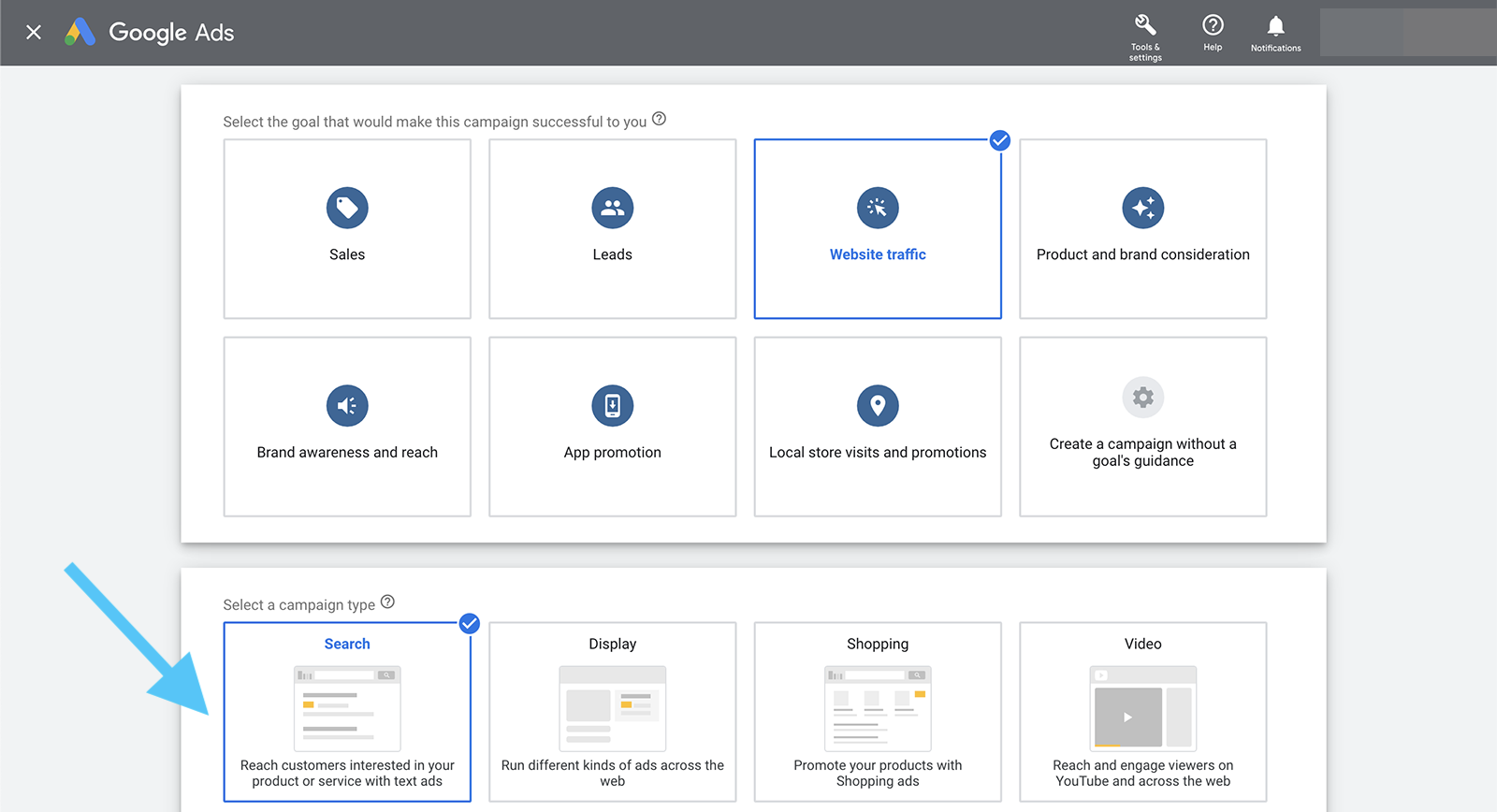
Decide on a daily budget, choose a bidding strategy, and select Google Ads targeting options to build an audience. On the Campaign Settings screen, deselect Display Network so your campaign can run on the Search Network only.
Upload your keyword list or get some help from Google’s Keyword Planner. Then create an RSA by adding the final URL, writing up to 15 headlines, and crafting up to 4 descriptions. You then have the option to configure ad extensions before launching your search campaign.
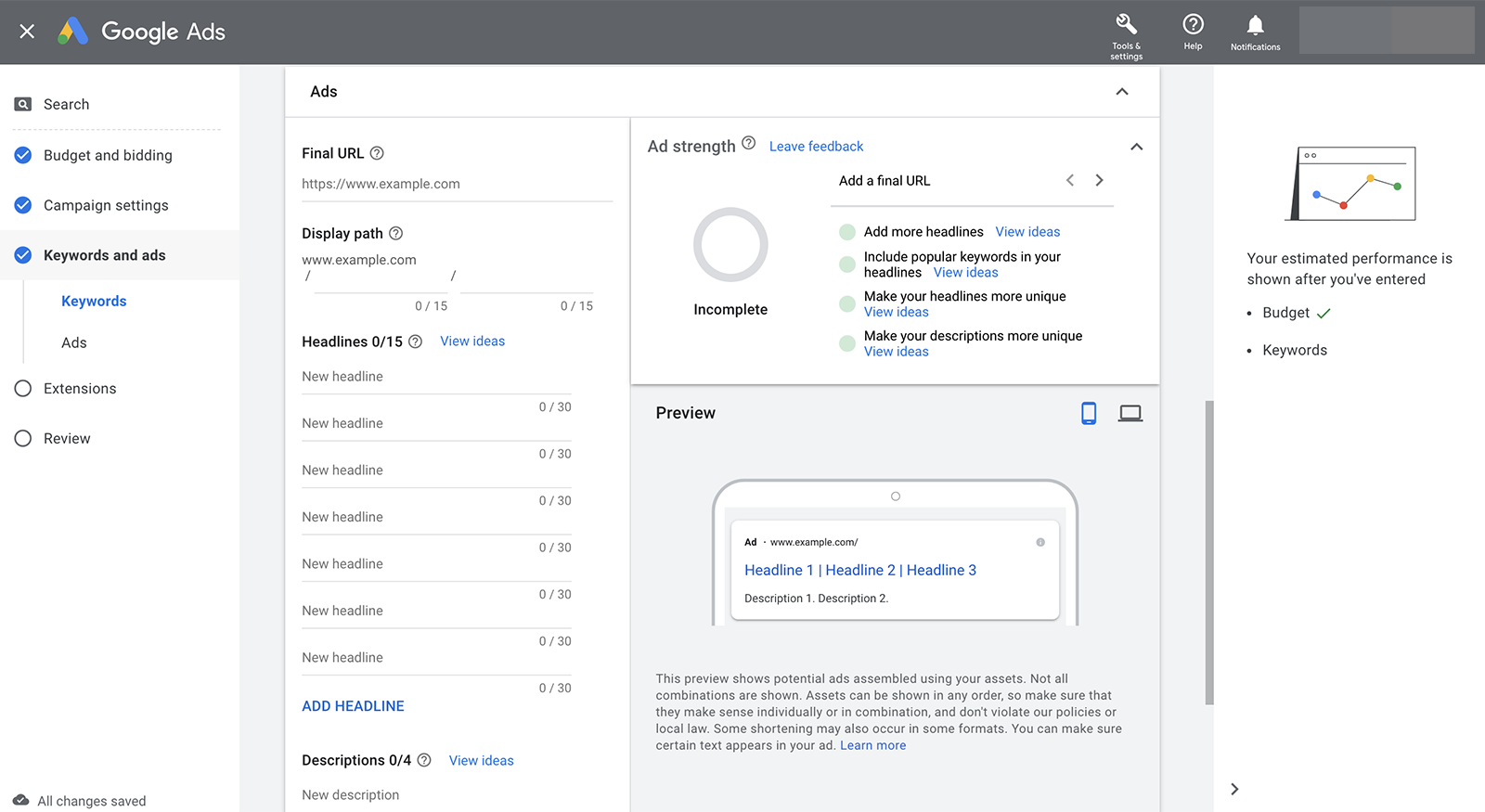
Once you create a campaign, you can add as many as three responsive search ads in each ad group. To create another RSA, choose an ad group and click the blue plus icon. Select Responsive Search Ad and go through the ad creation steps again.
Do you want to track leads, sales, or other actions that happen after the click? Set up conversion tracking in your Google Ads account so you can monitor and optimize for a wider variety of campaign outcomes.
Tips for creating the best responsive search ads
With so many options for optimizing RSA, it isn’t always easy to know where to focus your energy. Use these best practices to create more successful ads:
Write copy that makes sense in any order
Because responsive search ad elements can appear in various combinations and sequences, you can’t always control how the copy displays. To overcome this issue, avoid messaging that requires one headline to come before another or that depends on Google to match up certain headlines and descriptions.
Instead, create copy that’s easy to understand and prompts action no matter how the SERP displays it. Ensure that headlines and descriptions can be mixed, matched, and sequenced without compromising the quality of your ad or confusing your target audience.
Pin headlines selectively
Responsive search ads can display only a fraction of the total number of description and headline options you enter. You can’t expect all of them to appear every time Google serves your ad—but you can ensure that certain copy displays in a specific order.
When you create or update a search ad, you can pin your choice of headlines or descriptions. To the right of any ad copy field, click the pin icon and select the position where you want the headline or description to appear.
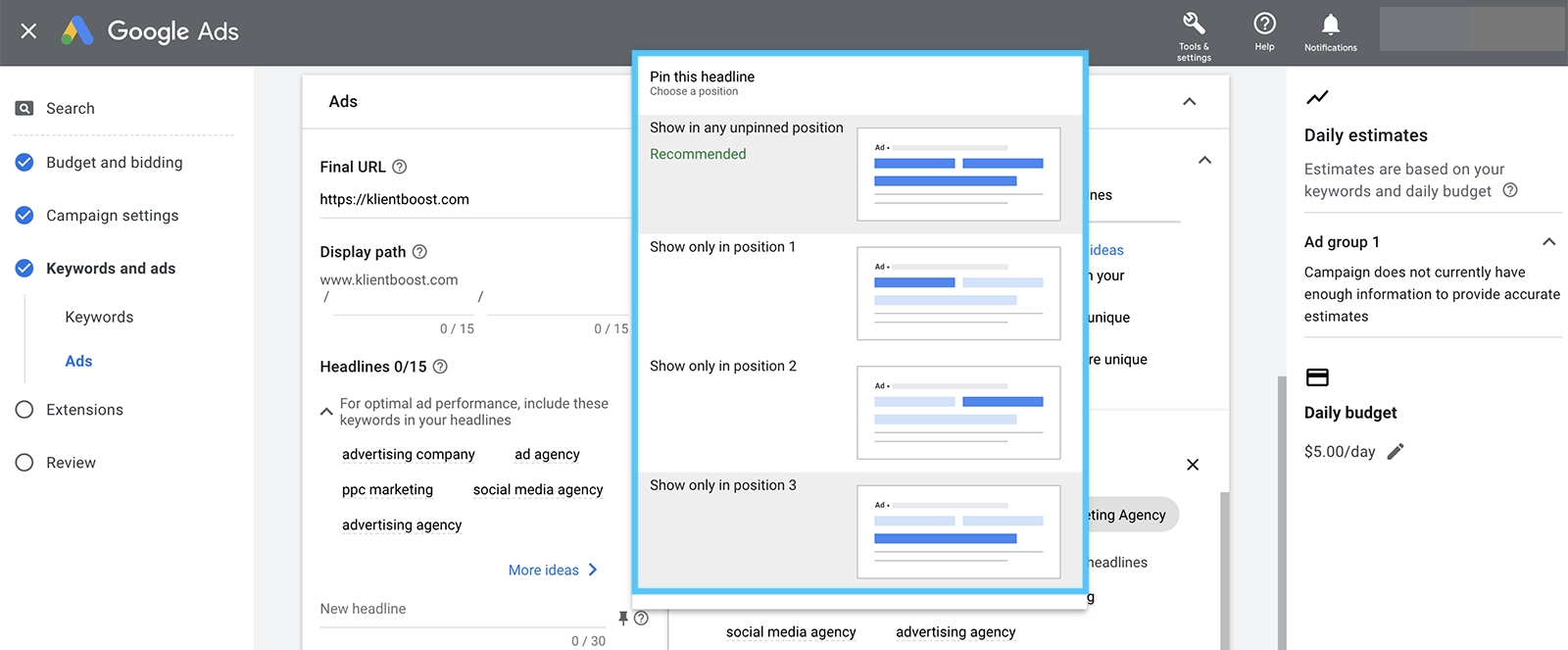
Pinning headlines and descriptions gives you more control over your RSA. But the more you pin, the fewer opportunities you give Google to optimize your ads automatically. For best results, pin only when it’s absolutely necessary for your ad to make sense.
Use the maximum number of fields and characters
Every RSA allows up to 15 headlines with 30 characters each and up to four descriptions with 90 characters each. That may sound like a lot, but it’s in your best interest to maximize both fields and character counts.
Naturally, the more ad copy you provide, the more opportunities Google Ads has to create winning combinations. To give Google as many options as possible, take care to make your headlines and descriptions distinct from one another.
Follow Google’s keyword suggestions
If you’re struggling to come up with the maximum number of descriptions or headlines, Google Ads can help. Once you enter your landing page, the platform automatically recommends search terms to include in your ad copy.
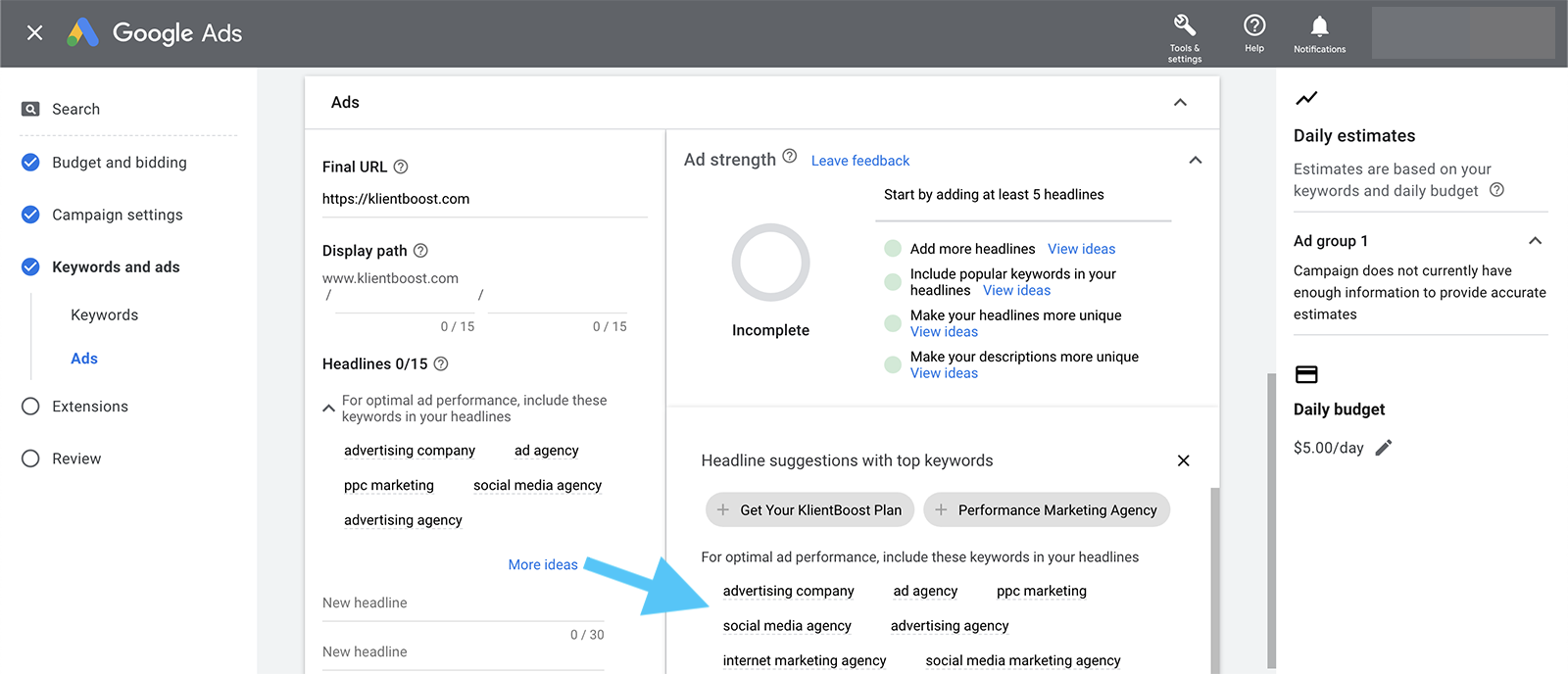
When you use all the recommended terms, the platform provides more to consider. Click the More Ideas link to see top keywords to include in your headlines and descriptions.
Aim for good or excellent ad strength
Every time you create or update a responsive search ad, Google Ads evaluates it to determine ad strength—which can range from Poor to Excellent. Google recommends ensuring that at least one responsive ad in each group has a Good or Excellent rating.
If your ad strength is Average or Poor, use the tips that the platform provides to improve your score. For example, you might write more headlines, incorporate more keywords, or add more diversity to your ad copy.
Test out ad variations
Responsive ads are great for optimizing search campaign results. But they aren’t necessarily ideal for testing at scale or quantifying the effects of small tweaks.

Instead, use ad variations to test out minor changes. To create an ad variation, select an ad group and click the plus icon. Then select Ad Variation and make some small changes. Decide on an end date for the test and choose what percent of people should see the variations. Then run the test, review the results, and optimize your RSA.
Pair responsive ads with the right keywords
When you upload a keyword list to a search ad group, you have to choose a match type. It’s tempting to use phrase match or even exact match to narrow your targeting.
However, Google recommends using broad match keywords with RSA campaigns. This keyword match type provides the best way to maximize your reach and drive optimal results.
In fact, if you use broad match keywords and Smart Bidding to build your responsive search campaign, Google estimates that you’ll receive an average of 20% more conversions for the same ad spend.
Optimize responsive search ads manually
It’s true that Google Ads automatically optimizes responsive ads for searchers and contexts. But that doesn’t mean the platform can make major changes like altering your message or writing better copy. That’s why it’s so important to review ad performance and update ads regularly.
To identify top-performing fields, create a Google Ads report and modify the columns to show headlines and descriptions. Then sort by the metrics that matter to your team, such as clicks, click-through rate (CTR), conversions, or conversion rate.

You can also identify headlines and descriptions that aren’t performing well by clicking on any RSA. Google Ads automatically displays notifications under poorly performing fields, recommending updates to improve results.
Get started with RSA
Are you ready to start running more effective search campaigns? Check out our guide to Google keywords and make sure your responsive search ads reach the right audience with the right message at the right time. Or, find a Google Ad agency that can do all the hard work for you.